*NURSING > STUDY GUIDE > NURS 6560 FINAL EXAM – QUESTION AND ANSWERS; LATEST 2019/2020, WALDEN. (All)
NURS 6560 FINAL EXAM – QUESTION AND ANSWERS; LATEST 2019/2020, WALDEN.
Document Content and Description Below
The AGACNP is caring for a patient who is quite ill and has developed, among other things, a large right sided pleural effusion. Thoracentesis is sent for pleural fluid analysis. While evaluating th... e fluid analysis, the AGACNP knows that a fluid identified as a(n) __________ is the least worrisome type. Response Feedback : “A” is the correct answer. A transudate is essentially just water and can occur as a consequence of increased hydrostatic pressure in the pulmonary vessels. It typically implies that the some condition has produced an imbalance in colloid-hydrostatic pressures, such as CHF or hypoalbuminemia. While it can represent a serious problem, it may also represent a transient imbalance. Conversely, “B” is not correct as an exudate has more protein in it and implies a condition characterized by protein leaking from vessels, such as a malignancy or some serious systemic stressor. “C” is not correct—a chyliform effusion is characterized by fat and indicates a pathology causing massive triglyceride degradation. “D” is not correct as a hemorrhagic effusion is blood and typically means traumatic injury. Question 2 0 out of 1 points Mrs. Miller is transported to the emergency department by paramedics. She is having profound, unremitting chest pain, is diaphoretic and pale. She has jugular venous distention and a widened pulse pressure. Suspecting ascending aortic aneurysm, the AGACNP order which test to confirm the diagnosis? Response Feedback : “D” is the correct answer. It is the most widely used diagnostic tool as it rapidly and precisely can outline the thoracic and abdominal aorta. “A” is not the correct answer—there are radiographic findings that suggest thoracic aneurysm, but they need confirmation by CT. “B” is not the correct answer as ultrasound is not nearly as precise as a CT scan. “C” is not correct—MRI is only indicated when the patient cannot have a contrast CT. Question 3 1 out of 1 points Certain subgroups of the elderly population are at an increased risk for rapid deterioration and long-term care placement. Which of the following is not considered a high risk factor for long term care placement? Response Feedback: “A” is the correct answer; men are at higher risk for long-term care placement than women. In addition to male gender, other risk factors include age over 80, living alone, bowel or bladder incontinence, history of falls, dysfunctional coping, and intellectual impairment. Question 4 0 out of 1 points A patient with anterior epistaxis has been treated with 20 minutes of direct pressure to the cartilaginous portion of the nose. Following pressure the patient is instructed to gently blow the nose. Expected findings in the patient who has been successfully treated include all of the following except a: Response Feedback : “C” is the correct answer. If bleeding is successfully stopped with 20 minutes of directed pressure, there will be residual blood and clot formation. This is evacuated either by gentle suction or having the patient gently blow. Residual blood and formed clot may present as a sudden gush of dark blood or discharge with or without a clot—these are all typical expected findings. However, if bleeding is not stopped, it will continue as a bright red steady trickle. When this occurs, more invasive measures are indicated. Question 5 0 out of 1 points Kevin is a 14-year-old male who presents for evaluation of a fever of 102.5° F and significant right ear pain. He appears quite ill and says he feels nauseous. Otoscopic evaluation reveals pain to palpation, a very erythematous and bulging tympanic membrane with bullous myringitis. The AGACNP knows that antibiotic therapy must be selected to cover: Response Feedback : “D” is the correct answer. Streptococcus pneumoniae is the most common bacteria that infects the head and neck in immunocompetent persons, and is the primary treatment target when treating otitis media, bacterial sinusitis, and bacterial pharyngitis. “A” is not correct—while likely on broken skin and soft tissue, it is not common in the ear, nose, or throat unless specific risk factors exist. “B” is not correct—this is much more likely in an immunocompromised patient or a patient on mechanical ventilation. “C” is not correct—it is the second most common organism, but strep is the primary treatment target. Question 6 1 out of 1 points P.M. is a 71-year-old gay male patient who presents as an outpatient for evaluation of increasing shortness of breath. The diagnostic evaluation ultimately supports a diagnosis of community acquired pneumonia. The AGACNP appreciates right middle lobe consolidation on chest radiography. Pending sputum cultures, empiric antibiotic therapy must be initiated to cover which organism? Response Feedback : “D” is the correct answer. This patient presents from the outpatient population where the most common cause of pneumonia is Streptococcus pneumoniae, and is the primary treatment target for any patient being treated empirically. “A” is not correct—while the patient’s sexual orientation is offered in the provided history, there is no indication that he has HIV/AIDS or any other condition characterized by immunosuppression that would increase his risk for this organism. “B” is not correct, as this organism is not typically seen in the outpatient population without specific risk, e.g. immunosuppression or chronic ventilator therapy. “C” is not the correct answer as this organism is not likely absent specific risk such as instrumentation or known colonization. Question 7 0 out of 1 points Which of the following is the greatest risk factor for vascular dementia? Response Feedback : “B” is the correct answer. Vascular dementia is a consequence of vascular disease, and is more likely to occur in patients with risk factors for target organ damage, such as hypertension, dyslipidemia, and diabetes. “A” is not a distinct risk factor for vascular dementia; it is a risk for Alzheimer’s dementia. “C” likewise increases risk for Parkinson’s dementia, but does not present a risk for vascular dementia. “D” is not a risk factor for vascular dementia. Although there may be some familial risk for certain vascular diseases that may lead to vascular dementia, there is no clear familial tendency for this type of dementia. Question 8 1 out of 1 points J.R. is a 55-year-old male who presents for a commercial driver’s license physical examination with a blood pressure of 170/102 mm Hg. He has no medical history and is without complaint. Which of the following findings constitutes hypertensive urgency? Response Feedback : “A” is the correct answer. According to the Joint National Committee (JNC) report, hypertensive urgency is described as hypertension in the setting of progressive target organ damage, such as renal involvement with protein leaking, left ventricular hypertrophy, or retinal changes. “A” is not correct— the headache may or may not be relevant, but because there are many non-hypertension causes, a headache alone does not constitute target organ damage. “C” is not correct—it may indicate carotid plaque, but this is not a consequence of hypertension. “D” is not correct as a 1+ palpable pulse may be a normal finding--it must be taken in the context of the rest of the examination. Question 9 0 out of 1 points Because of the commonly recognized adverse effects of atypical antipsychotics, annual laboratory assessment for patients taking these medications should include a: Response “C” is the correct answer. The atypical antipsychotics such as olanzapine Feedback : (Zyprexa), clozapine (Clozaril), and quetiapine (Seroquel) are classically associated with dyslipidemia and annual lipid panels should be performed in patients of all ages who take these medications. “A” is incorrect—this is the appropriate annual screening tool for patients on lithium due to lithium-related iodine suppression of the thyroid gland. There are no specific indications for “B” and “D” unique to patients taking atypical antipsychotics. Those laboratory assessments should only be ordered as indicated by any other significant patient history. Question 10 1 out of 1 points K.R. presents for an evaluation of eye discomfort. He works in a fabricating shop for a custom automobile restoration company and while working he felt like something flew into his eye. He was wearing eye protection at the time but still has the sensation that something is there. Physical examination is significant for some tearing and he reports a persistent sense of something in his eye. Which of the following is not indicated in the diagnostic evaluation? Response Feedback : “B” is the correct answer. The patient’s history is consistent with a metal injury and so an MRI should be avoided. “A” may or not be indicated as the history progresses, but there is no contraindication to it should the examiner determine the need to rule out an abrasion. “C” and “D” are both mechanisms to visualize behind the cornea which may be necessary if a penetration injury (which may occur with a high-velocity injury) is suspected. Question 11 0 out of 1 points D.E. is a 41-year-old female who had lumbar surgery two days ago to repair a ruptured nucleus pulposus. She has been doing well postoperatively but today is complaining of resting fatigue and some shortness of breath at rest. In ruling out a pulmonary embolus the AGACNP first orders a: Response Feedback : “B” is the correct answer. The D-dimer is a highly sensitive serology and is the least invasive mechanism by which a pulmonary embolus may be ruled out; a negative D-dimer virtually eliminates pulmonary embolus from the differential diagnosis. “A” is not correct—while it can be used to make the diagnosis it is more invasive and less specific than other options. “D” is not correct—there is no indication that the patient is on warfarin, and in any event it would not be used to rule in or out pulmonary embolus “C” is not accurate when after surgery, as it will be positive after surgery. Question 12 0 out of 1 points Mr. Nixon is being treated with unfractionated heparin infusion for acute pulmonary embolus. In order to avoid a potentially fatal complication of heparin infusion, the AGACNP monitors: Response Feedback : “D” is the correct answer. An uncomm [Show More]
Last updated: 1 year ago
Preview 1 out of 35 pages

Reviews( 0 )
Recommended For You
*NURSING> STUDY GUIDE > NR 602 Chamberlain College of Nursing_ NR 602 Week 8 Final Exam – NR 602 Primary Care of Childbearing and Childrearing Family Exam. ALL POSSIBLE QUESTION & CORRECT ANSWERS (All)
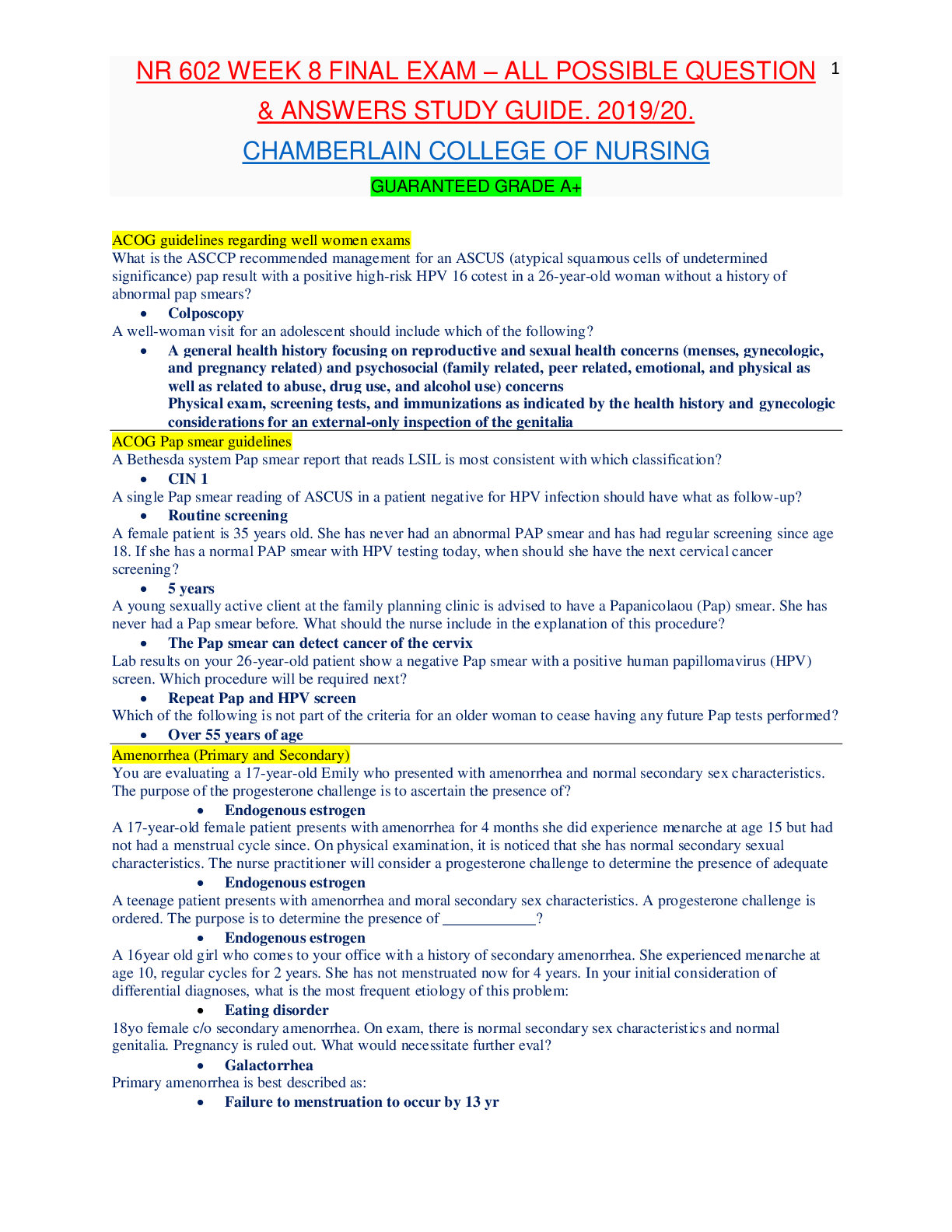
NR 602 Chamberlain College of Nursing_ NR 602 Week 8 Final Exam – NR 602 Primary Care of Childbearing and Childrearing Family Exam. ALL POSSIBLE QUESTION & CORRECT ANSWERS
NR 602 - Chamberlain College of Nursing NR 602 WEEK 8 FINAL EXAM ACOG guidelines regarding well women exams 1. What is the ASCCP recommended management for an ASCUS (atypical squamous cells of unde...
By Expert#1 , Uploaded: Oct 10, 2019
$8
Health Care> STUDY GUIDE > ATI MED SURG FINAL EXAM / ATI MED SURG FINAL EXAM – STUDY GUIDE (2021) Correct Questions & Answers (All)
.png)
ATI MED SURG FINAL EXAM / ATI MED SURG FINAL EXAM – STUDY GUIDE (2021) Correct Questions & Answers
ATI MED SURG FINAL EXAM – STUDY GUIDE (2021) 1. The nurse is caring for a client receiving enteral tube feedings who suddenly begins coughing with a sudden drop in oxygen saturation. The nurse suspec...
By doctorsolutions , Uploaded: Aug 04, 2022
$16
Health Care> STUDY GUIDE > ATI Med Surg Proctored Final Exam – Study Guide 2021/2022 (All)
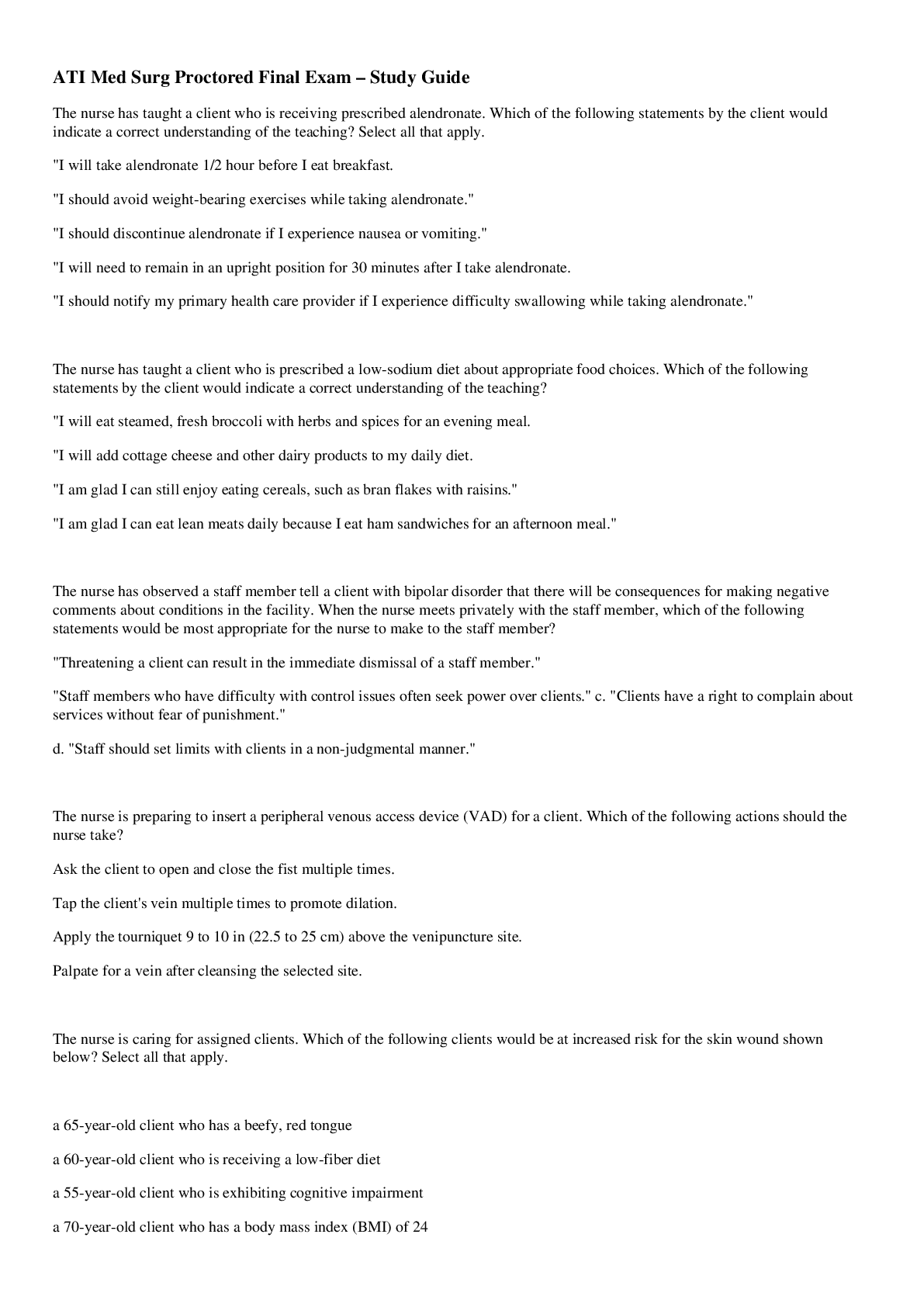
ATI Med Surg Proctored Final Exam – Study Guide 2021/2022
ATI Med Surg Proctored Final Exam – Study Guide 1. The nurse has taught a client who is receiving prescribed alendronate. Which of the following statements by the client would indicate a correct unde...
By doctorsolutions , Uploaded: Aug 03, 2022
$15
Health Care> STUDY GUIDE > ATI MENTAL HEALTH PROCTORED FINAL EXAM – (STUDY GUIDE) 2022 (All)
.png)
ATI MENTAL HEALTH PROCTORED FINAL EXAM – (STUDY GUIDE) 2022
ATI MENTAL HEALTH PROCTORED FINAL EXAM – (STUDY GUIDE) Crisis intervention-empathy ● Implement interventions designed to address the client's needs ● Get the entire story from the client's perspective...
By doctorsolutions , Uploaded: Aug 01, 2022
$14
Health Care> STUDY GUIDE > ATI Med Surg Final Exam – Study Guide 2021 (All)

ATI Med Surg Final Exam – Study Guide 2021
ATI Med Surg Final Exam – Study Guide 2021 1. How would you communicate with a person who is hearing impaired? a. Bring voice down to a lower pitch and face the patient. 2....
By doctorsolutions , Uploaded: Jul 21, 2022
$16
Health Care> STUDY GUIDE > Ati Pharmacology Proctored Final Exam – Study Guide / Correct Questions & Answers - Keiser University (All)
.png)
Ati Pharmacology Proctored Final Exam – Study Guide / Correct Questions & Answers - Keiser University
Ati Pharmacology Proctored Final Exam – Study Guide Toxicity of this medication results in yellow-green halos, visual disturbances, nausea, vomiting, and abdominal pain Digoxin Fast-acting insuli...
By doctorsolutions , Uploaded: May 12, 2022
$16
Health Care> STUDY GUIDE > ATI PHARMACOLOGY PROCTORED FINAL EXAM – STUDY GUIDE 200+ Correct Questions & Answers (All)
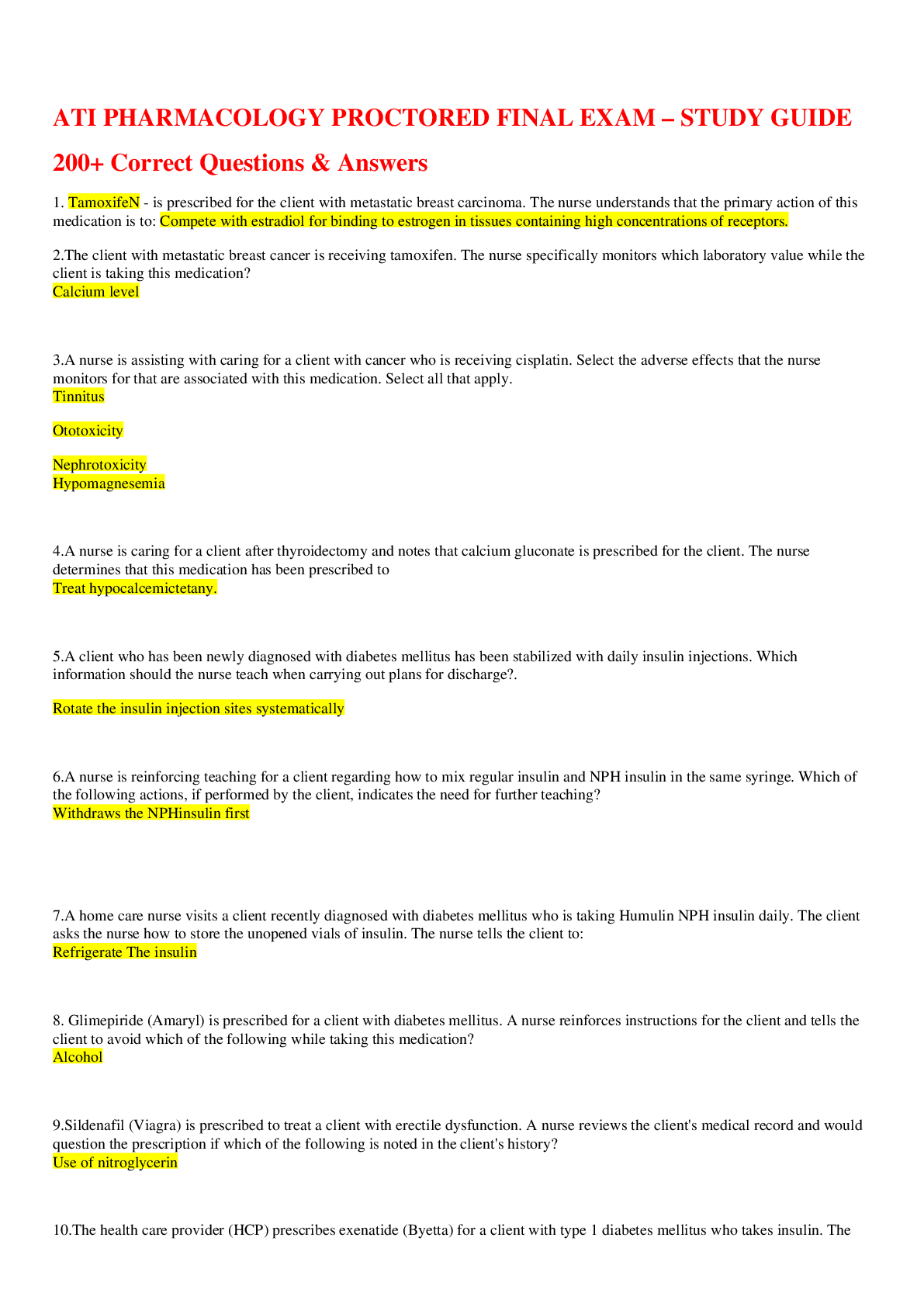
ATI PHARMACOLOGY PROCTORED FINAL EXAM – STUDY GUIDE 200+ Correct Questions & Answers
ATI PHARMACOLOGY PROCTORED FINAL EXAM – STUDY GUIDE 200+ Correct Questions & Answers 1. TamoxifeN - is prescribed for the client with metastatic breast carcinoma. The nurse understands that the pri...
By doctorsolutions , Uploaded: May 12, 2022
$17
*NURSING> STUDY GUIDE > HLTH 3115 Final Exam – Question And Answers (All)
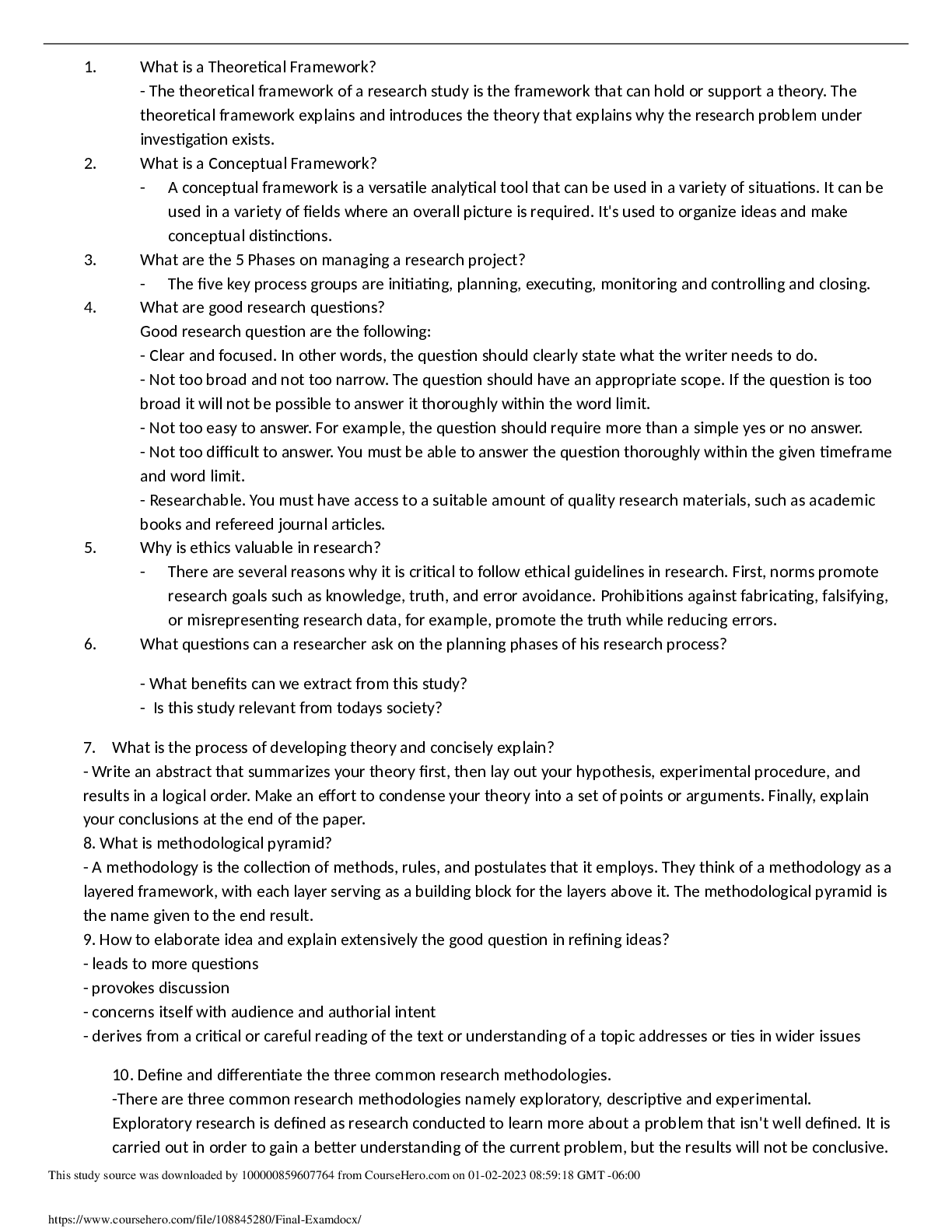
HLTH 3115 Final Exam – Question And Answers
HLTH 3115 Final Exam – Question And Answers
By Good grade , Uploaded: Mar 01, 2022
$7
Health Care> STUDY GUIDE > HESI RN MENTAL HEALTH 4 FINAL EXAM – REVISION GUIDE 2020/2021 Correct Questions & Answers (All)

HESI RN MENTAL HEALTH 4 FINAL EXAM – REVISION GUIDE 2020/2021 Correct Questions & Answers
HESI RN MENTAL HEALTH 4 FINAL EXAM – REVISION GUIDE 2020/2021 1. A woman admitted to the Emergency Department is bleeding profusely from a patch where hair was lost from her scalp. She is accompani...
By doctorsolutions , Uploaded: Jan 17, 2022
$16
Health Care> STUDY GUIDE > HESI RN MENTAL HEALTH 4 FINAL EXAM – REVISION GUIDE 2020/2021 Correct Questions & Answers with Rationales (All)
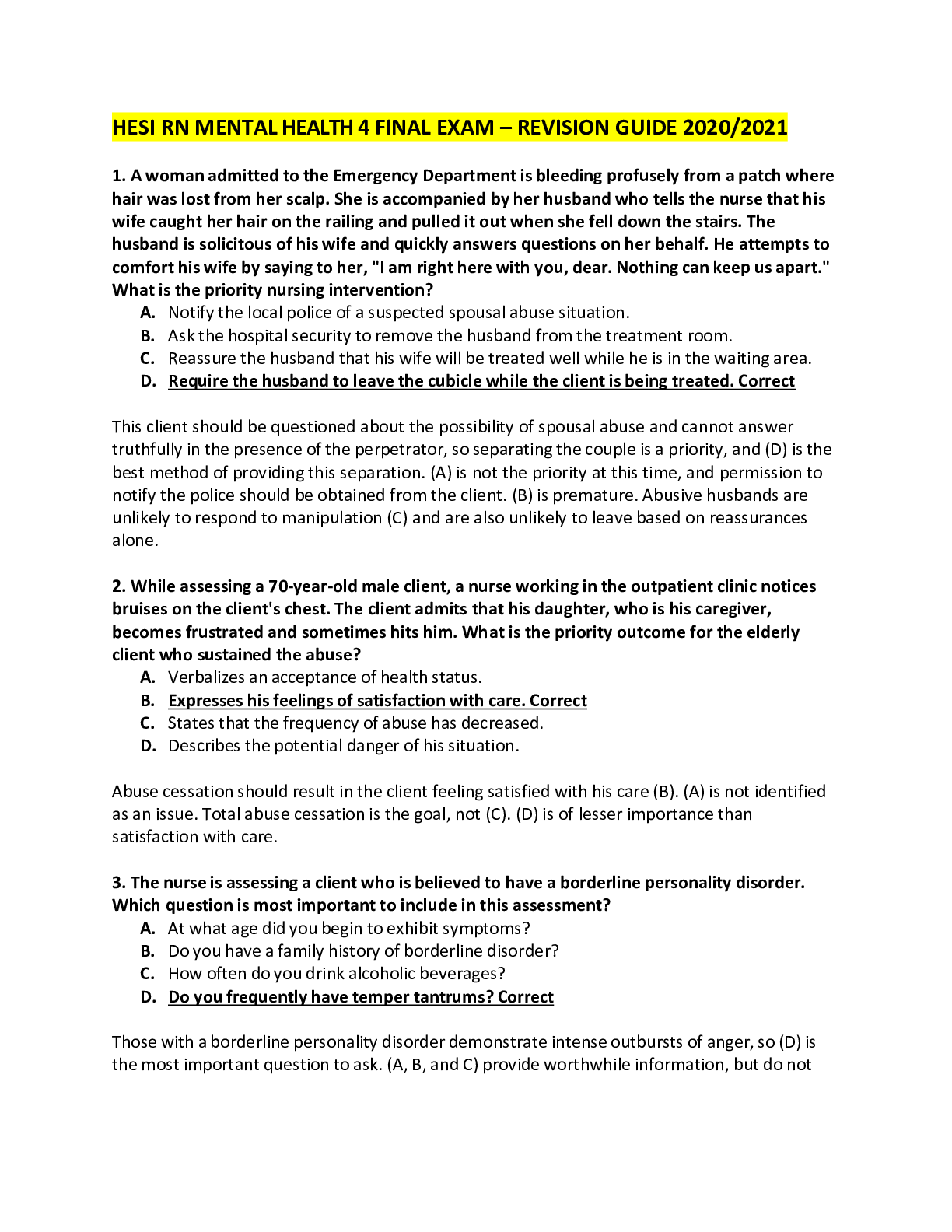
HESI RN MENTAL HEALTH 4 FINAL EXAM – REVISION GUIDE 2020/2021 Correct Questions & Answers with Rationales
HESI RN MENTAL HEALTH 4 FINAL EXAM – REVISION GUIDE 2020/2021 1. A woman admitted to the Emergency Department is bleeding profusely from a patch where hair was lost from her scalp. She is accompani...
By doctorsolutions , Uploaded: Jan 17, 2022
$15
Document information
Connected school, study & course
About the document
Uploaded On
Jan 28, 2023
Number of pages
35
Written in
Additional information
This document has been written for:
Uploaded
Jan 28, 2023
Downloads
0
Views
77






